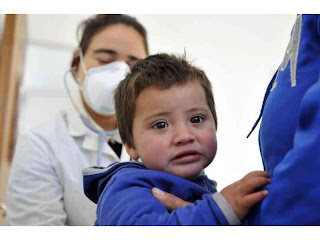A study in Argentina and other countries in Latin America and the Caribbean drew the "identikit" precise germs responsible for pneumonia in children and confirmed that this serious lung infection, which predominates in the autumn-winter, affects all ages but is three times more common in children under one year compared to those with two to five years.
"We found that the bacterium that causes this disease more often in boys in our region is the pneumococcus or Streptococcus pneumoniae," said Ariel Bardach, a medical epidemiologist and researcher at the Institute for Clinical Effectiveness and Health, based in Buenos Aires. In decreasing order other disease-causing bacteria are Haemophilus influenzae, Mycoplasma pneumoniae and Staphylococcus aureus. "This pattern is similar to other regions of the world," says Bardach.
According to another author of the study published in International Journal of Infectious Diseases, the infectious disease medical Angela Gentile, viruses are the most common causes of pneumonia in children under 1 year. The head of Epidemiology Gutiérrez Children's Hospital of Buenos Aires said: "In newborns (younger than 1 month) should take into account the possibility of group B streptococci, coliforms and Staphylococcus aureus. After 3 years of age in cmbio, Mycoplasma pneumoniae prevalence begins to increase. "
Also, Gentile noted that the introduction of vaccination against Haemophilus influenzae type b to the national schedules of the countries of the region (conducted in different years, depending on the country involved) has reduced significantly the prevalence of this organism.
"The study also showed that children under 1 year are those with the highest incidence of pneumonia, reaching triple that observed in children 2 to 5 years old," says Bardach.
To reach these results, the researchers collected data from 24 000 cases of pneumonia in ambulatory children under 5 years of Latin America and the Caribbean. The methodology used was what is known as "systematic review", which is to gather information in all the bibliographic databases of scientific studies, reports from hospitals, information from the Pan American Health Organization (PAHO) and major conferences on subject.
According to Gentile and Bardach, the data are a critical tool in public health to predict and evaluate the impact of a prevention measure, which in this case is the pneumococcal vaccine (currently included in the immunization schedules of most Latin America and the Caribbean).
"We found that the bacterium that causes this disease more often in boys in our region is the pneumococcus or Streptococcus pneumoniae," said Ariel Bardach, a medical epidemiologist and researcher at the Institute for Clinical Effectiveness and Health, based in Buenos Aires. In decreasing order other disease-causing bacteria are Haemophilus influenzae, Mycoplasma pneumoniae and Staphylococcus aureus. "This pattern is similar to other regions of the world," says Bardach.
According to another author of the study published in International Journal of Infectious Diseases, the infectious disease medical Angela Gentile, viruses are the most common causes of pneumonia in children under 1 year. The head of Epidemiology Gutiérrez Children's Hospital of Buenos Aires said: "In newborns (younger than 1 month) should take into account the possibility of group B streptococci, coliforms and Staphylococcus aureus. After 3 years of age in cmbio, Mycoplasma pneumoniae prevalence begins to increase. "
Also, Gentile noted that the introduction of vaccination against Haemophilus influenzae type b to the national schedules of the countries of the region (conducted in different years, depending on the country involved) has reduced significantly the prevalence of this organism.
"The study also showed that children under 1 year are those with the highest incidence of pneumonia, reaching triple that observed in children 2 to 5 years old," says Bardach.
To reach these results, the researchers collected data from 24 000 cases of pneumonia in ambulatory children under 5 years of Latin America and the Caribbean. The methodology used was what is known as "systematic review", which is to gather information in all the bibliographic databases of scientific studies, reports from hospitals, information from the Pan American Health Organization (PAHO) and major conferences on subject.
According to Gentile and Bardach, the data are a critical tool in public health to predict and evaluate the impact of a prevention measure, which in this case is the pneumococcal vaccine (currently included in the immunization schedules of most Latin America and the Caribbean).




0 comments:
Post a Comment